It has been an interesting eight months at FC Koln, where they have managed to work their way through three managers. First, it was Markus Anfang, sacked in the closing stages of the 2018/19 season as Koln looked to be faltering in the run-in towards the climax of the 2. Bundesliga campaign. They brought in Achim Beierlorzer to right the ship and ensure promotion. He achieved that goal, but after languishing too long in the lower echelons of the Bundesliga, and with the risk of losing touch with the rest of the pack, they once again pulled the plug.
Eyebrows were raised upon the appointment of Markus Gisdol who has had a relatively steady if unspectacular managerial career thus far. Yet there can be no doubt that Gisdol has turned things around in Koln.
His tenure started with a difficult 4-1 loss to RB Leipzig, a draw against Augsburg and another loss to Union Berlin. Since then they have beaten Bayer Leverkusen, Eintracht Frankfurt, and Werder Bremen. In their last four games, they scored seven, whilst keeping two clean sheets.
This tactical analysis will look at the tactics used by Gisdol to gain such success in such a short space of time.
Are there any obvious changes that have occurred?
Initially, I wanted to title this article “What Koln are doing differently under Markus Gisdol”, but that would perhaps be overstating things. For Koln seem to be doing a lot of what they’ve been doing all season, but under Gisdol they are just doing it better. As a coach, his overarching philosophy is probably very similar to that of Beierlorzer. He likes to be direct in possession, and create openings to play forward quickly, and break the lines effectively. Gisdol has likely looked at what Koln did well under Beierlorzer whilst added in some minor changes to help them improve as a side.
Under Beierlorzer Koln used a 4-2-3-1 formation more frequently as the season progressed, and Gisdol has continued to use this.
A glance at the statistics in Gisdol’s short reign thus far show that overall there is little difference to what Koln are doing in the attack, albeit there are slight improvements.
They are averaging 0.66 more shots per game, taking shots slightly closer to goal, and have minimally improved in their xG, although it is early days.
Defensively there are more noticeable improvements. They are allowing three fewer shots on goal per game, and also fewer shots on target, which would go some way to explaining their three clean sheets in Gisdol’s six games in charge, and they continue to press high as they did under Beierlorzer.
Koln’s pressing structure
Under Beierlorzer Koln were renown for an aggressive press and as mentioned above, that hasn’t changed. Gisdol puts an emphasis on protecting the central spaces and when out of possession, Koln take up a particularly narrow shape.
The press will often present itself still in the 4-2-3-1 formation, with the initial press coming in the form of a front three. However, the central player in the front three that are pressing, will generally avoid pressing the central defenders. Instead, they will sit a little deeper, blocking the initial central passing lane, and forcing the defenders to pass laterally as the analysis below shows.
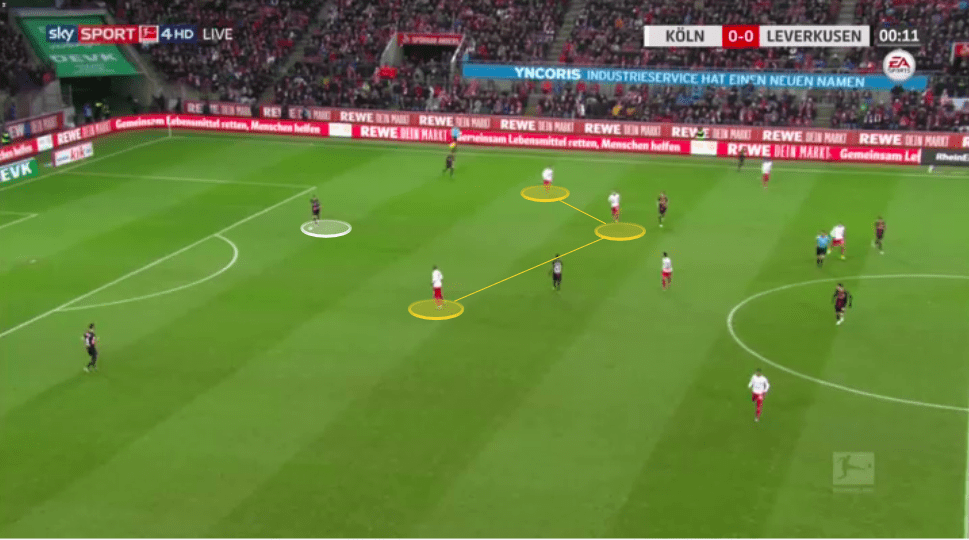
It is as this point where he will be supported by his teammates who will press the defender who has received in a wider area, whilst the other two balance the press and forms a screen centrally, as the image below shows.
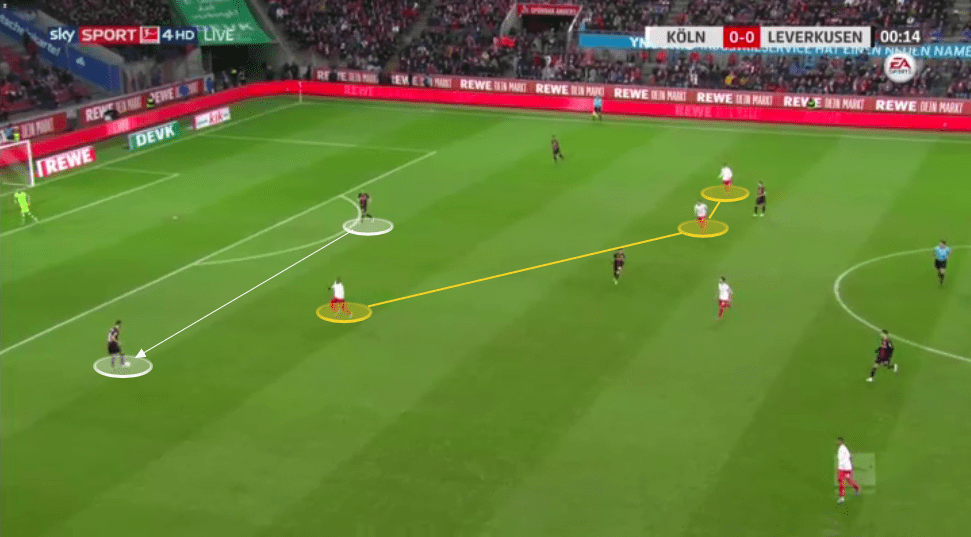
The initial aim is to arc their run to force the man in possession to play down the line, however, if the defence resists this and play laterally once again, they will regroup and do the same once more should it be necessary.
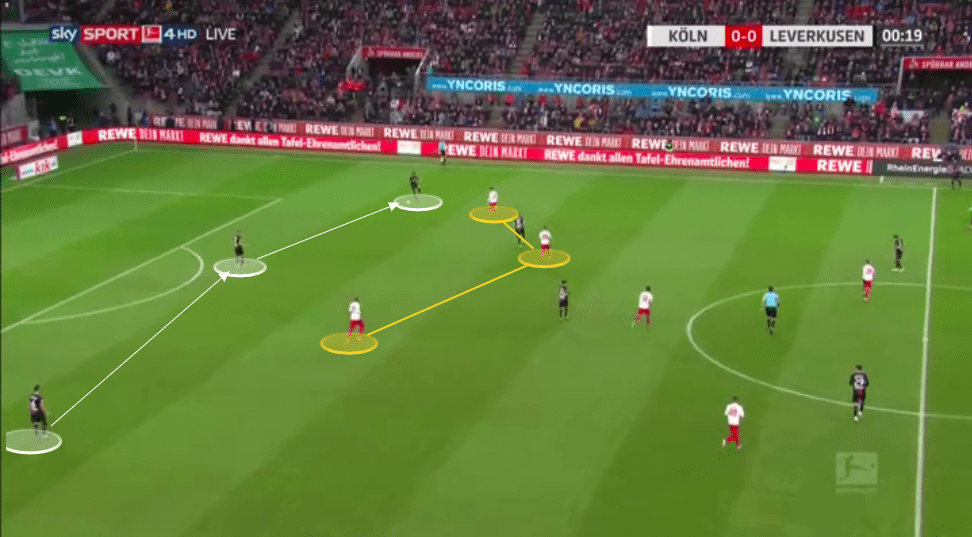
The press will, of course, vary based on the opposition and although it varies, a constant throughout is protecting the central areas. If the press is beaten with a central-midfielder dropping in to receive, as Werder Bremen did in the image below, Koln have the numbers centrally to prevent a side playing through the middle of them. Should the opposition decide to play inside with a diagonal pass into the centre of the pitch, the two closest players to the ball in an advanced area (as they don’t want to bring their deeper midfielders out of position) will create traffic and prevent the opposition from having easy possession.
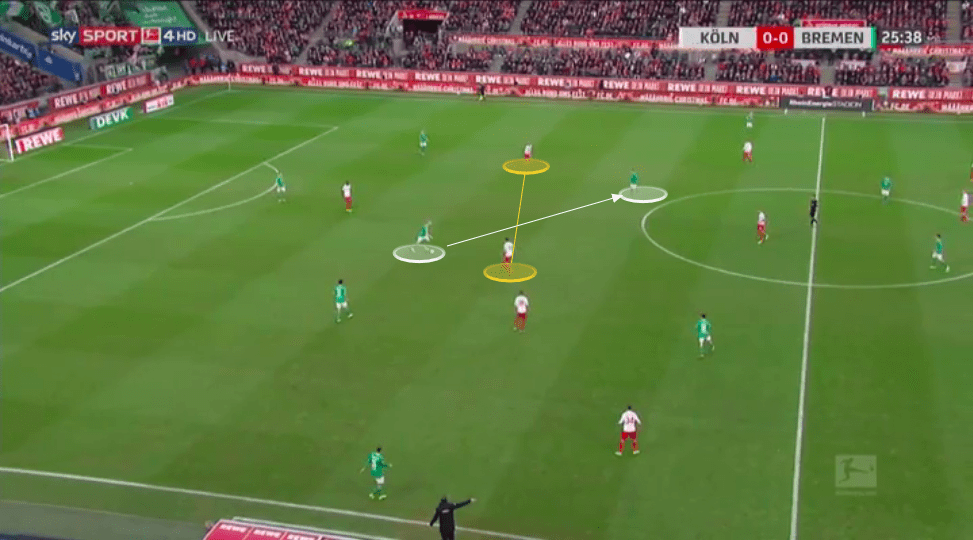
The image below shows how quickly these two players swarm around the ball, without affecting the rest of Koln’s shape.
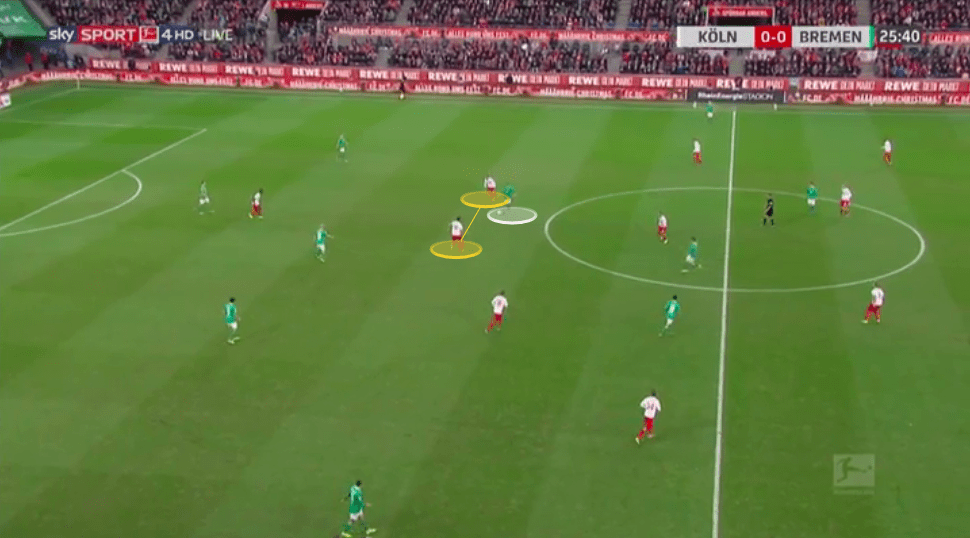
When the ball is in a slightly more advanced area, they press less aggressively and drop into a 4-1-4-1 shape with their defensive midfielder sitting incredibly close to the back four as a screen. In this scenario, they instead seek to block the passing lanes. A backwards pass from midfield into defence, or a lateral pass in defence, is the trigger for them to activate the press more aggressively, and one of the inside forwards who has dropped deeper to create the defensive 4-1-4-1, will push forward to support their centre-forward who will generally remain pretty central.
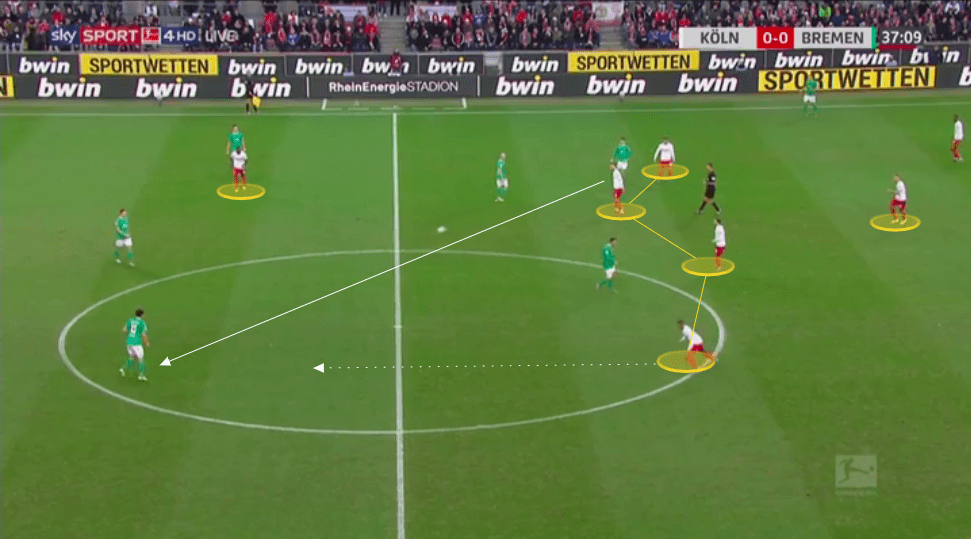
Koln’s build-up play under Gisdol
If you’re playing against Koln, it’s a safe bet that very few of their attacks will come from the central midfielders. Or at least not from an orthodox central-midfield position.
Gisdol has his side build their attacks from the flanks, whether that’s long passes into the forward line from the full-back positions, or creating numerical overloads in wide areas to penetrate the wings and get crosses into the box.
Gisdol doesn’t like to overcommit, wary of being susceptible to counter-attacks, and his full-backs will never stray too far from their centre-backs.
With a ball in a more advanced position, the full-backs will often push as high as the defensive midfielder, but won’t venture too much farther forward, aside from the odd overlap if they are looking to overload the flanks. They are generally available to play diagonal crosses from further out, and they are far enough forward that the front three can play close to one another.
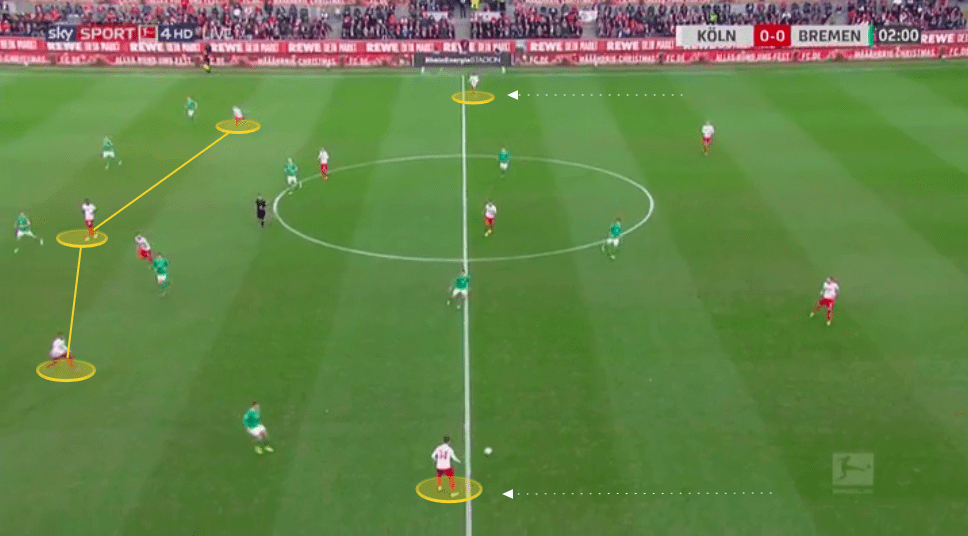
When a Koln full-back has possession in a deep wide area, one of their centre-midfielders will sometimes look to push high and occupy the position of an orthodox winger.
This allows Koln to initially retain a narrow front three, and based on the full-backs passing decision, they can adapt.
Should the full-back look to play down the line to the central-midfielder, they can create a 3 v 2 overload with the full-back supporting and a forward coming wide to play quick interchanges as they seek to get in behind the opposition defence via the flank.
The image below shows how the two Koln players have positioned themselves in the right touchline that brings Werder Bremen’s defensive shape further across, allowing the space for the centre-back to play directly into the centre-forward.
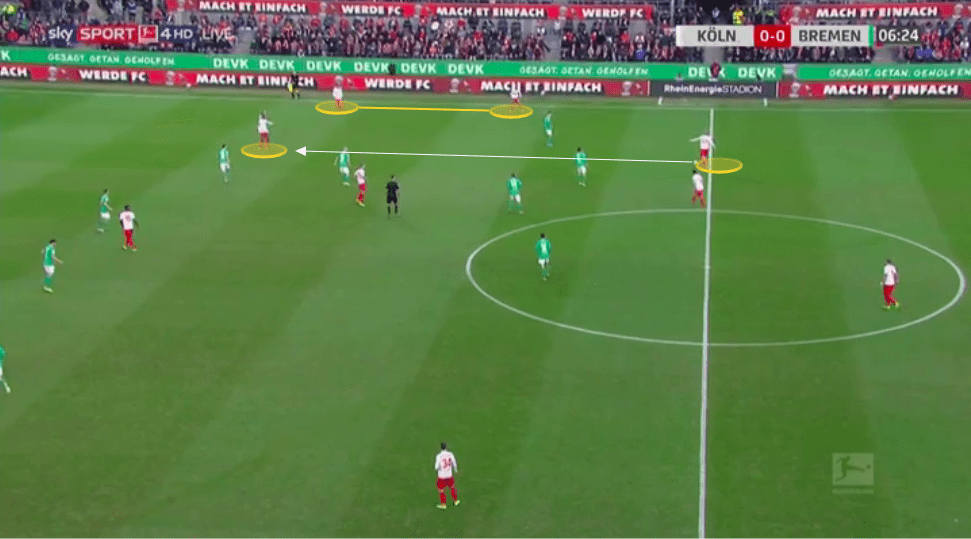
If they are unable to penetrate this space then they look to quickly rotate the ball to the opposite flank.
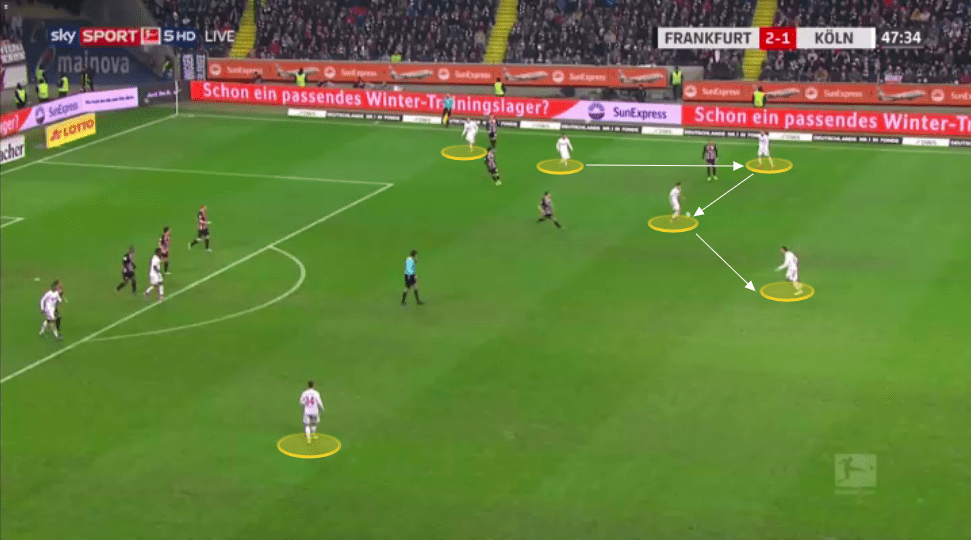
However, this run by the central-midfielder into the flank also allows the left-back to play directly into the frontman.
Koln look to encourage the opposition to press and this naturally creates plenty of space between their defenders and forwards which they look to exploit.
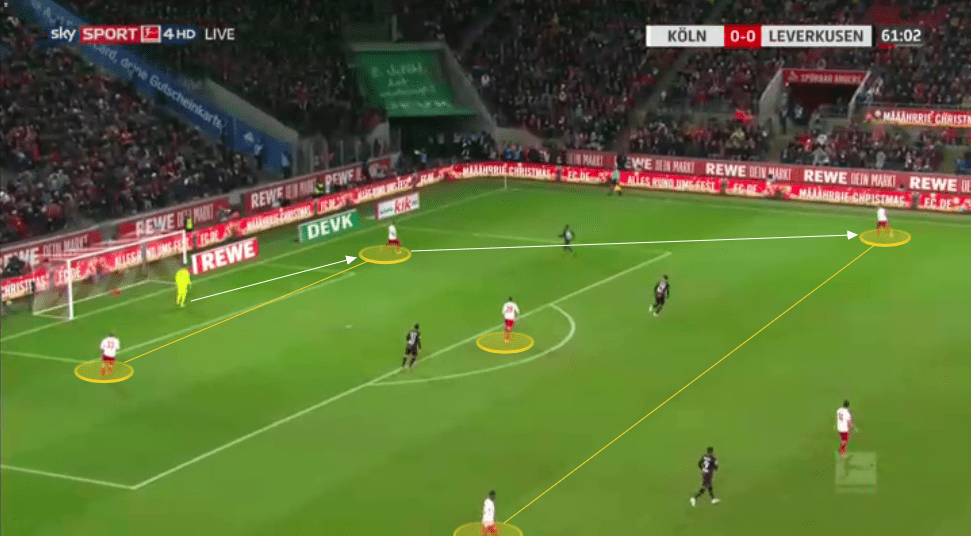
This sequence leads to the left-back gaining possession, as the full-backs sit somewhat deep but nevertheless beyond the initial line of press.
The image below is an example of the centre-midfielder recognizing the ball being played to the left-back and beginning to make his run.
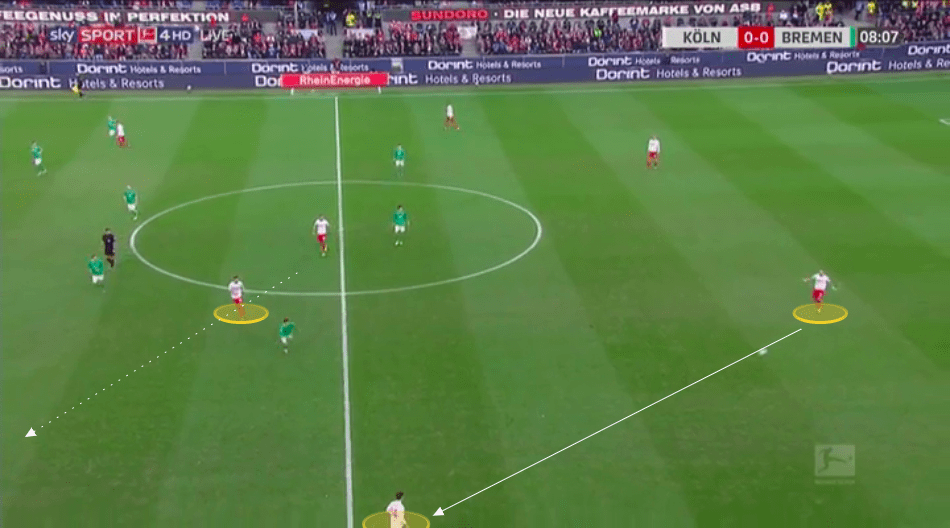
Once he sees this happening he makes his run into a left-wing position. His run will ideally take a marker with him, leaving plenty of space centrally, but that is not essential. The left-back is then able to play a diagonal long pass along the ground into the feet of the target man, bypassing the entire midfield.
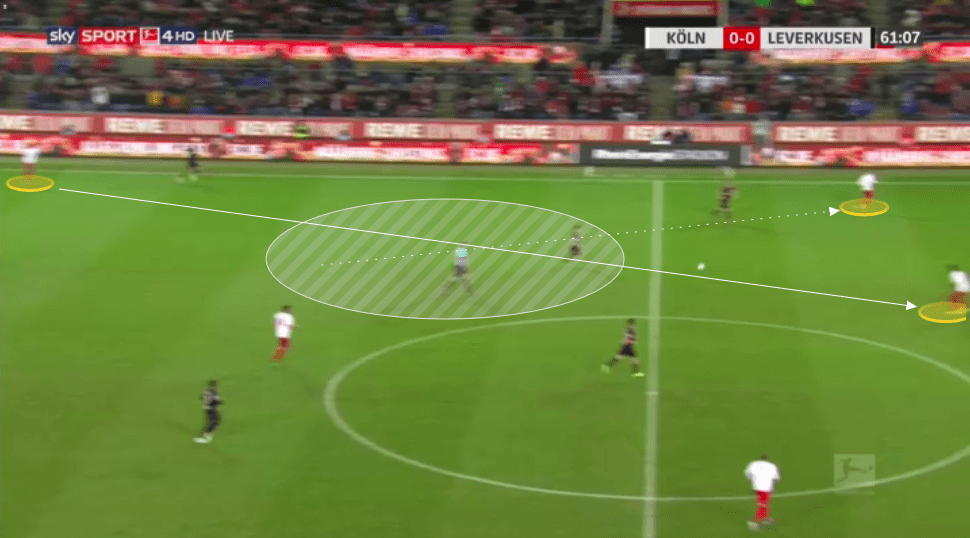
A criticism of Beierlorzer was that there were times where there were a lot of long balls played forward to Modeste, with plenty of these in the air. Modeste has been involved in 10.04 aerial duels per 90 minutes this season, the fifth-most in the league. Under Gisdol Modeste is averaging just over six aerial duels per 90, which is a significant reduction.
Gisdol still likes to get the ball into him early. However, with the movement of their central-midfielders into wide areas as they play from the back, it creates plenty of space in the midfield to break the lines with a pass from deep, directly into Modeste’s feet, rather than his head.
How they use Modeste or Jhon Córdoba to get behind the opposition defence
Make no mistake, Koln are still a direct team, and despite the fact that they do work the ball in wide areas, as mentioned earlier, their priority is absolutely to get the ball forward as quickly as possible, into the front two or three, and attack space behind the opposition defence.
They have done his particularly effectively in their recent run of wins. Either Modeste or Córdoba will play as the target man. Koln look to play plenty of balls forward into the target man, and playing with a narrow front three means there are always players to pick up loose balls. Modeste or Córdoba are used to help Koln move forward quickly and bring others into play in more advanced areas. Their talent in holding up the ball brings opposition defences forward and leaves space in behind.
They are often used essentially as a target and a long pass will be played towards them but will be purposefully overhit. A simple curved run is often enough for them to beat the defensive line.
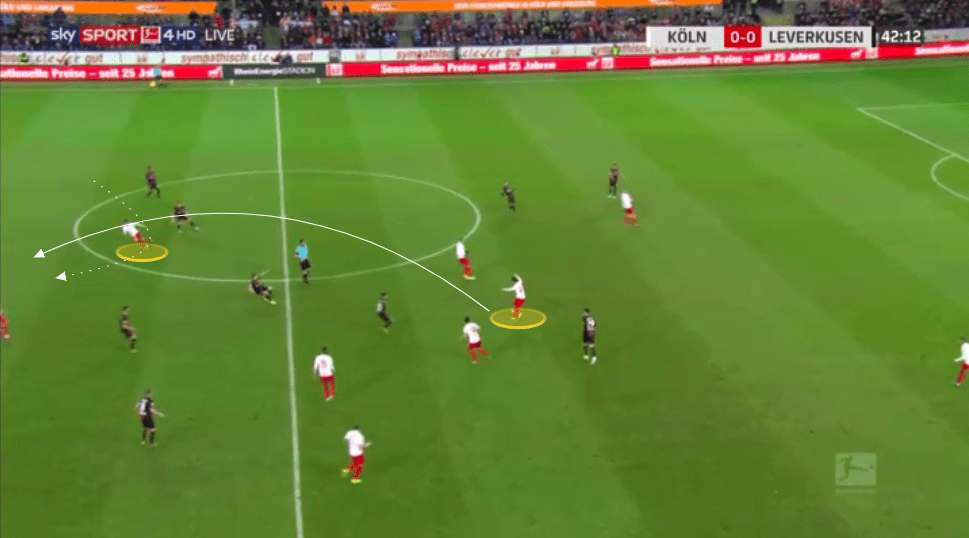
Modeste and Córdoba are by no means short of pace but Gisdol surrounds them with quick players. The likes of Ismail Jakobs, Jan Thielmann, and Dominik Drexler are able to support too. These players will always look to exploit the space behind, particularly when Modeste or Córdoba doesn’t make a run. In the image below Modeste holds his position, keeping the opposition backline high, allowing his teammate to run from the centre past Modeste, and in doing so creating space in behind with a large gap between the defenders.
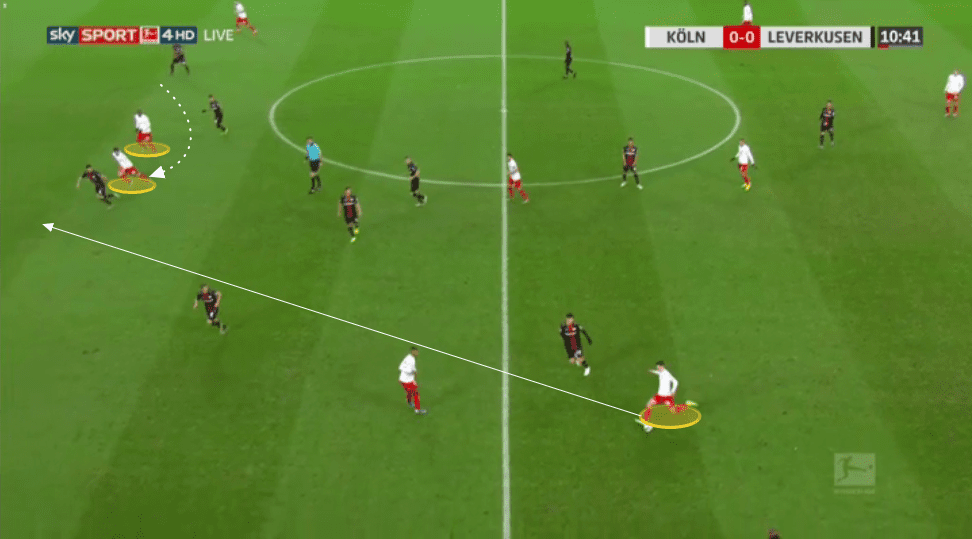
Conclusion
Rather than seek to reinvent the wheel by appointing a new manager halfway through the season with a totally different philosophy, Koln took what has turned out to be an excellent decision thus far. Koln are effectively playing the same brand of football, but are having a lot more success with it, thanks to a few slight changes, and likely a fresh face and voice on the training ground.
Of course, it is far too early to say that Koln are out of the woods, particularly as they are still sat precariously above the relegation places, but it is nevertheless a big step in the right direction, as well as giving the club a new sense of momentum going into the second half of the season, particularly after finishing the first half with such an impressive run.
We will find out very quickly, as the season restarts, whether Koln have turned a leaf, as their first run of games are probably the toughest any club in the Bundesliga has in that period, as they face Wolfsburg, Dortmund, Freiburg, Mönchengladbach, Bayern Munich and Schalke, all before the end of February.



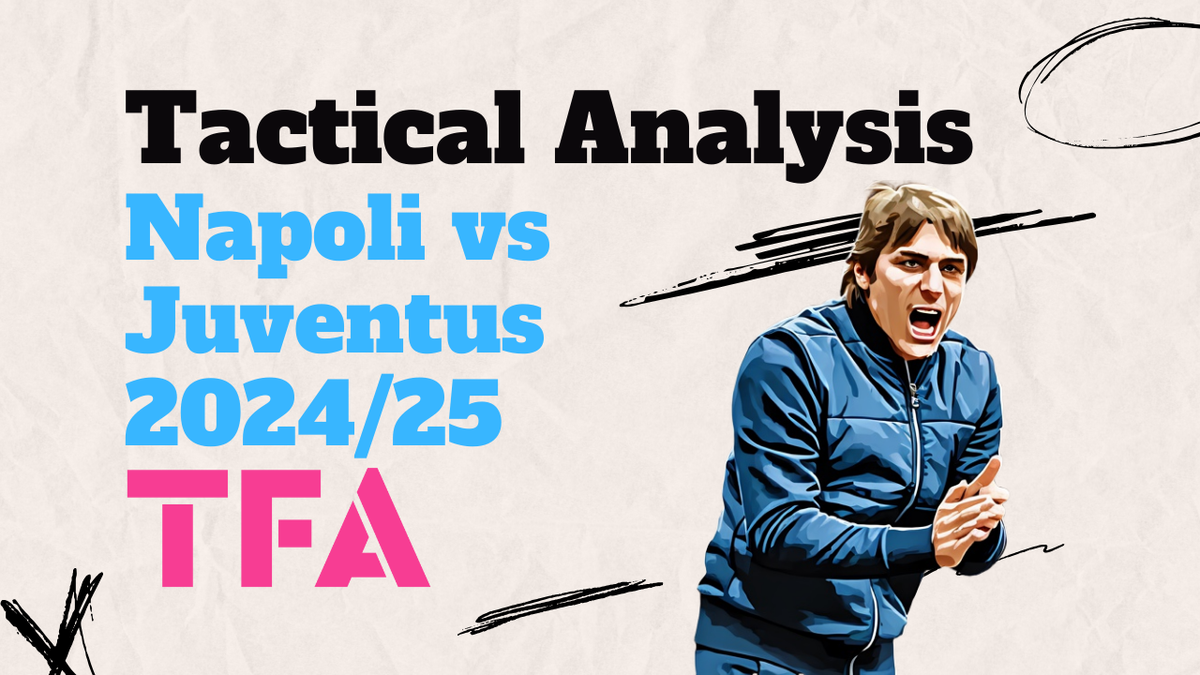
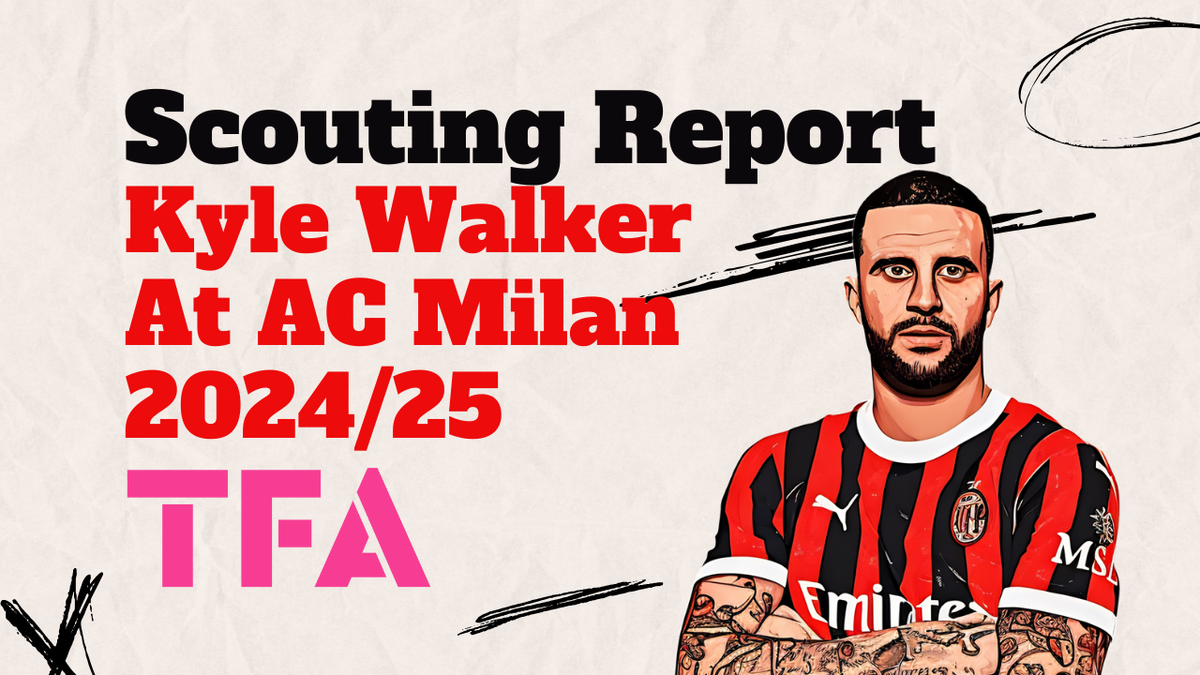
Comments